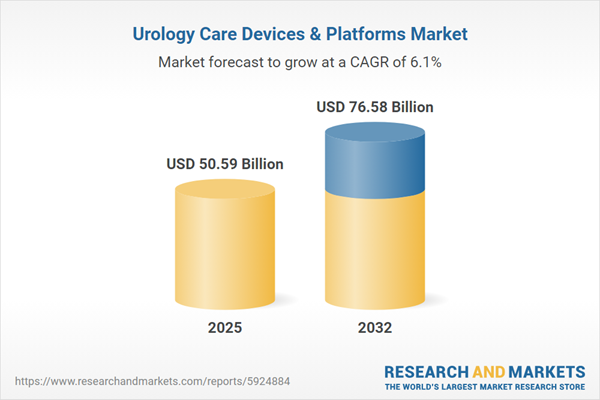Speak directly to the analyst to clarify any post sales queries you may have.
The urology care devices and platforms market is advancing as healthcare leaders adapt to evolving clinical demands and competition. Focused innovation in technology and service delivery is shaping new opportunities for organizations striving for operational resilience and sustainable growth.
Market Snapshot: Urology Care Devices & Platforms Market
The global urology care devices and platforms market is experiencing steady expansion, with revenues forecast to rise from USD 47.74 billion in 2024 to USD 50.59 billion by 2025, and ultimately reaching USD 76.58 billion by 2032. This trajectory reflects a compound annual growth rate of 6.08% over the forecast period.
Growth drivers include demographic changes such as an aging population and increasing incidence of urinary disorders. Additionally, accelerated adoption of minimally invasive procedures and digital health technologies is transforming patient care delivery. Organizations that realign strategies to these trends are positioned to enhance both patient outcomes and operational performance.Scope & Segmentation of the Urology Care Devices & Platforms Market
- Product Type: Diagnostic platforms comprise biomarker-based systems, urodynamics equipment, and imaging tools (CT, MRI, ultrasound, X-ray), with visualization devices like cystoscopes and ureteroscopes supporting procedure accuracy. Therapeutic devices such as catheters, stents, and lithotripsy units offer targeted interventions to address various clinical needs.
- Application: Solutions span management of benign prostatic hyperplasia, urologic tumors, urinary stones, overactive bladder, multiple forms of incontinence, and other conditions. This broad applicability supports patient care across acute and chronic episodes.
- End User: Hospitals, ambulatory surgical centers, diagnostic laboratories, outpatient clinics, and home care providers utilize urology platforms to enable centralized care as well as decentralized delivery, improving patient access and care coordination.
- Procedure Type: The market covers invasive, minimally invasive, and non-invasive procedures, including catheterization, endoscopy, laparoscopic surgery, open surgery, and advanced treatments such as shockwave therapy.
- Technology: The field features electrohydraulic systems, various laser technologies (holmium, thulium, greenlight, CO2), advanced optical imaging (fluorescence, narrow band), and modalities like pneumatic, ultrasonic, magnetic resonance, and radio-frequency systems, all of which elevate diagnostic precision and treatment effectiveness.
- Region: Coverage includes the Americas, Europe, the Middle East, Africa, and Asia-Pacific, each presenting unique regulatory criteria, technology adoption trends, and commercial maturity stages, making regional adaptation important for success.
- Leading Companies: Key market participants—Boston Scientific Corporation, Olympus Corporation, Medtronic plc, Coloplast A/S, Becton Dickinson and Company, Teleflex Incorporated, ConvaTec Group plc, Intuitive Surgical Inc., Stryker Corporation, and Johnson & Johnson—drive innovation, product launches, and global collaboration shaping the industry landscape.
Key Takeaways for Decision-Makers
- Integrated urology platforms expand access to advanced care, streamline patient journeys, and support more precise management across diverse clinical indications.
- Digital health adoption, including telemedicine and analytics, boosts coordination among providers and maximizes workflow efficiency in complex healthcare networks.
- Asia-Pacific’s early technology adoption is stimulating marketplace evolution, while North America and Europe provide regulatory frameworks that shape global best practices.
- Collaboration between device suppliers and manufacturers enhances supply chain resilience, improves product availability, and ensures timely delivery in a dynamic environment.
- Continued development in imaging and catheterization supports organizations in responding to shifting procedural volumes and new compliance requirements.
- Segmented capabilities help streamline operations in organizations of varying sizes and specialties, optimizing resource allocation amid market transitions.
Tariff Impact & Competitive Strategy
Recent changes to United States tariffs have raised the cost of importing urology care devices, prompting manufacturers to invest more in domestic production and partnerships with regional suppliers. These actions underpin continued innovation and support a stable supply chain, safeguarding market access in the face of increased trade barriers.
Methodology & Data Sources
This report synthesizes direct feedback from senior executives, broad-based industry surveys, and comprehensive analysis of sector intelligence and regulatory information. The methodology ensures actionable insights that reflect emerging trends and market realities.
Why This Report Matters
- Offers strategic direction on capital allocation, portfolio initiatives, and adoption of next-generation urology technologies using the latest validated intelligence.
- Clarifies supply chain, reimbursement, and regulatory trends, supporting enhanced risk management and readiness strategies for senior leadership.
- Facilitates partnership development and market responsiveness through timely insights into evolving competitor dynamics and technology uptake.
Conclusion
Organizations prioritizing strategic flexibility, advanced technology, and collaborative partnerships will strengthen their ability to address clinical and operational challenges while maintaining competitive positioning in a changing global market.
Additional Product Information:
- Purchase of this report includes 1 year online access with quarterly updates.
- This report can be updated on request. Please contact our Customer Experience team using the Ask a Question widget on our website.
Table of Contents
3. Executive Summary
4. Market Overview
7. Cumulative Impact of Artificial Intelligence 2025
Companies Mentioned
The companies profiled in this Urology Care Devices & Platforms market report include:- Boston Scientific Corporation
- Olympus Corporation
- Medtronic PLC
- Coloplast A/S
- Becton, Dickinson and Company
- Teleflex Incorporated
- ConvaTec Group PLC
- Intuitive Surgical, Inc.
- Stryker Corporation
- Johnson & Johnson
Table Information
| Report Attribute | Details |
|---|---|
| No. of Pages | 191 |
| Published | November 2025 |
| Forecast Period | 2025 - 2032 |
| Estimated Market Value ( USD | $ 50.59 Billion |
| Forecasted Market Value ( USD | $ 76.58 Billion |
| Compound Annual Growth Rate | 6.0% |
| Regions Covered | Global |
| No. of Companies Mentioned | 11 |









